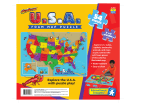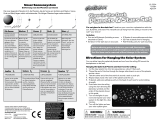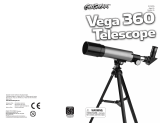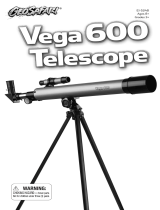Educational Insights GeoSafari® Glow-in-the-Dark Solar System Product Instructions
- Type
- Product Instructions
This manual is also suitable for
Educational Insights GeoSafari® Glow-in-the-Dark Solar System is a fun and educational way to learn about the solar system. This glow-in-the-dark solar system includes the Sun, 8 planets, and their moons, dwarf planets, asteroids, and comets. The planets vary greatly in size. The Sun, the star at the center of our solar system, is so large more than a million Earths could fit inside it! The diameter of the Sun and each planet is given below.
- Sun: 870,000 miles
- Mercury: 3,031 miles
- Venus: 7,521 miles
- Earth: 7,926 miles
- Mars: 4,222 miles
- Jupiter: 88,700 miles
- Saturn: 75,000 miles
Educational Insights GeoSafari® Glow-in-the-Dark Solar System is a fun and educational way to learn about the solar system. This glow-in-the-dark solar system includes the Sun, 8 planets, and their moons, dwarf planets, asteroids, and comets. The planets vary greatly in size. The Sun, the star at the center of our solar system, is so large more than a million Earths could fit inside it! The diameter of the Sun and each planet is given below.
- Sun: 870,000 miles
- Mercury: 3,031 miles
- Venus: 7,521 miles
- Earth: 7,926 miles
- Mars: 4,222 miles
- Jupiter: 88,700 miles
- Saturn: 75,000 miles




-
 1
1
-
 2
2
-
 3
3
-
 4
4
Educational Insights GeoSafari® Glow-in-the-Dark Solar System Product Instructions
- Type
- Product Instructions
- This manual is also suitable for
Educational Insights GeoSafari® Glow-in-the-Dark Solar System is a fun and educational way to learn about the solar system. This glow-in-the-dark solar system includes the Sun, 8 planets, and their moons, dwarf planets, asteroids, and comets. The planets vary greatly in size. The Sun, the star at the center of our solar system, is so large more than a million Earths could fit inside it! The diameter of the Sun and each planet is given below.
- Sun: 870,000 miles
- Mercury: 3,031 miles
- Venus: 7,521 miles
- Earth: 7,926 miles
- Mars: 4,222 miles
- Jupiter: 88,700 miles
- Saturn: 75,000 miles
Ask a question and I''ll find the answer in the document
Finding information in a document is now easier with AI
Related papers
-
Educational Insights EI-5237 User manual
-
 Educational Insights U.S.A. Foam Map Puzzle Product Instructions
Educational Insights U.S.A. Foam Map Puzzle Product Instructions
-
 Educational Insights GeoSafari® Glow-in-the-Dark Planets & Stars Set Product Instructions
Educational Insights GeoSafari® Glow-in-the-Dark Planets & Stars Set Product Instructions
-
 Educational Insights GeoSafari Lightwriter Product Instructions
Educational Insights GeoSafari Lightwriter Product Instructions
-
 Educational Insights GeoSafari® Omega Reflector Telescope User manual
Educational Insights GeoSafari® Omega Reflector Telescope User manual
-
Educational Insights GeoSafari® Omega Refractor Telescope Product Instructions
-
 Educational Insights Vega 360 User manual
Educational Insights Vega 360 User manual
-
 Educational Insights GeoSafari® Vega 600 Telescope User manual
Educational Insights GeoSafari® Vega 600 Telescope User manual
Other documents
-
Elenco EDU37113 Owner's manual
-
Meade 70AZ-ADS User manual
-
Meade 90AZ-ADRB User manual
-
Meade 70AZ-ADR User manual
-
 Meade Instruments 209004 Owner's manual
Meade Instruments 209004 Owner's manual
-
Meade 60AZ-AR User manual
-
 Meade Instruments Infinity 60AZ and 70AZ Owner's manual
Meade Instruments Infinity 60AZ and 70AZ Owner's manual
-
Meade 60AZ-A2 User manual
-
Meade 114EQ-ASTR User manual
-
Meade LightBridge User manual











